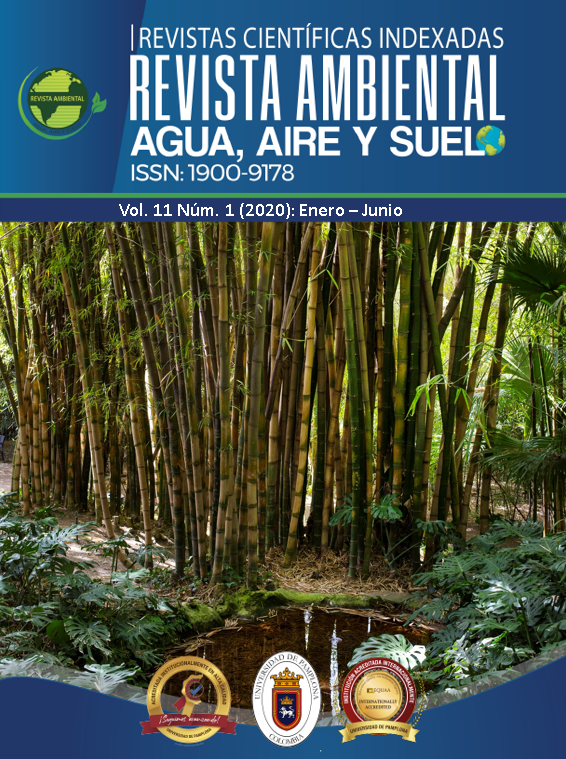Development of an autonomous device for improving water quality in the Córdoba Wetland (Bogotá, Colombia)
DOI:
https://doi.org/10.24054/aaas.v11i1.355Keywords:
Aireación, amonio, energía fotovoltaica, eutrofización, sistema de controlAbstract
The Córdoba wetland (Bogotá, Colombia) is a water system that is severely affected by wastewater discharge and activities carried out by the urban matrix in its vicinity. This study presents the design, construction, and operation of a portable device for the simultaneous removal of solids and ammoniacal nitrogen from the waters of the Córdoba wetland, which enables an increase in dissolved oxygen through gravity aeration. To this end, it uses photovoltaic energy and incorporates a control system for filter clogging and hose obstruction, with the aim of ensuring autonomous operation.
Variables such as energy loss, diameter and density of filter materials, contact time, electricity consumption, and weight, among others, were considered. All designs and efficiency tests were carried out in accordance with standardized norms. The dimensions of the device were estimated based on hydraulic retention time. The results obtained allowed the efficiency of the system to be measured, with average removals of 74.4% and 89.5% for ammonium and total solids, respectively, and an increase in dissolved oxygen concentration of up to 45%, treating a flow rate of 14 L/min with an autonomous working capacity of 3.5 hours. It is concluded that the designed device is a promising alternative for improving the water quality of the Córdoba wetland in situ, which can potentially be used for water treatment in other water systems with similar characteristics.
Downloads
References
APHA. (2005). Standard methods for the examination of water and wastewater (21st ed., pp. 258-259). WEF.
Angulo, W. J., Mendoza, J. A., & Uriel, H. U. (2017). Análisis de la vulnerabilidad por fenómenos de remoción en masa en la Cuenca Tanauca: Estudio de caso. Revista Ambiental Agua, Aire y Suelo, 8(2). https://doi.org/10.24054/19009178.v2.n2.2017.3276
Camargo, W. C. (2016). Modelación hidrológico-hidráulica de eventos de inundación en el Río Bogotá (sector Tocancipá-Chía) usando HEC-RAS. Revista Ambiental Agua, Aire y Suelo, 7(2). https://doi.org/10.24054/19009178.v2.n2.2016.3267
Cárdenas, G., Sánchez, I., Maya, J., & Solarte, A. (2015). Remoción de sólidos en aguas residuales de producción intensiva de trucha en un sistema de recirculación cerrado. Revista UNIMAR, 33(1), 229-236.
Cárdenas, A., & Medina, J. (2017). Diseño y construcción de una planta de tratamiento de agua potable a escala para el laboratorio de hidráulica de la Universidad Santo Tomás. Universidad Santo Tomás.
Fair, G., Geyer, J. C., Okun, D. A., & Ayanegui, J. S. (1999). Ingeniería sanitaria y de aguas residuales (Vol. 2). Limusa.
Fundación Humedales Bogotá. (2013). El caudal ecológico del humedal Córdoba. Recuperado de http://humedalesbogota.com/2013/03/18/el-caudal-ecologico-del-humedal-cordoba/
Gualteros Díaz, L. J., & Chacón Rodríguez, M. A. (2015). Estudio de la eficiencia de lechos filtrantes para la potabilización de agua proveniente de la quebrada La Despensa en el municipio Guaduas, Cundinamarca, vereda La Yerbabuena. Universidad de La Salle.
Guillot, G., & Pinilla, A. (2017). Estudios ecológicos en humedales de Bogotá: Aplicaciones para su evaluación, seguimiento y manejo. Universidad Nacional de Colombia.
Hamoda, M. F., Al-Ghusain, I., & Al-Mutairi, N. Z. (2004). Sand filtration of wastewater for tertiary treatment and water reuse. Desalination, 164(3), 203-211.
Downloads
Published
Issue
Section
License
Copyright (c) 2021 REVISTA AMBIENTAL AGUA, AIRE Y SUELO

This work is licensed under a Creative Commons Attribution-NonCommercial 4.0 International License.










